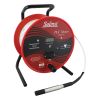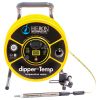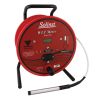Heron conductivity plus Water Level Meters
Features
- High-tensile steel core tape, tested for stretch resistance to ASME standards
- 4-electrode conductivity probe displays values up to 80,000 micro-siemens
- Probe is 7/8" diameter x 5.5" long (2.2cm x 14cm)
- Free ground shipping
- Expedited repair and warranty service
- Lifetime technical support
- More
Overview
The Heron conductivity plus Level and Temperature Meter accurately measures conductivity, water level and temperature in wells, boreholes, stand pipes and open bodies of water. The meter can be used to profile conductivity and temperature to depths of 1000 ft (300m).
Design
The Heron conductivity plus uses a measuring tape with a high tensile steel core, tested for stretch resistance to ASME standards. Two seven strand stainless steel conductors add to the strength of the tape. The tape graduations are in decimal feet with markings at each 1/100th foot or metric with markings at each mm.
A super bright red LED and an 80dB buzzer are also housed in the module. The electronics are based on A/C current, helping prevent probe corrosion and fouling. All electronics are protected from dust and moisture by an epoxy-based conformal coating. The unit is powered by a single 9V battery also housed within the module. The standalone, sturdy steel frame is coated in Polyurethane for durability, and the vinyl-coated carry handle is ergonomically designed for comfort and easier rewinding.
Mechanics
The probe utilizes a four-electrode system comprising of two arrays of a single electrode within a concentric electrode. Water level is sensed when the probe passes from a non-conductive medium (air) to a conductive medium (water). The meter measures the temperature and automatically converts readings to specific conductivity values. Calibration is easy using readily-available 1413us solution. The electronics module houses an LCD screen which displays conductivity values up to 80,000 micro-siemens and a temperature range from 0 C to +50 C.
- Premium Stainless Steel Polyethylene Coated Tape
- 7/8” (22.2mm) Conductivity Probe (IP68) w/ holder
- Electronic Panel with audio and visual signals (Fully Encapsulated to IP65)
- High Contrast LCD Display
- Vinyl, ergonomic holding grip
- 9V Battery
- Backpack Carrying Case w/ adjustable straps, laptop & notepad pouches
- 1 x 1413μ S Conductivity Solution
In The News
Three Decades of Research at Acton Lake
A multi-disciplinary team at Miami University, Ohio, has been studying the environmental change at Acton Lake for over three decades. Using three different NexSens buoys over this time, the team has an incredible archive of data that is helping build a picture of Acton’s past, present, and future. Until recently, a NexSens CB-50 buoy was used alongside other environmental monitoring at Acton Lake. In May 2025, the Miami team deployed a new XB-200 buoy , future-proofing their ongoing monitoring using real-time buoy systems. Acton Lake, a small hypereutrophic reservoir in southwest Ohio, covers 2.4km² and has a maximum depth of about 8m. The dam was built in 1956, and the lake has a large agricultural watershed.
Read MoreSource Water Monitoring in Albany, New York: Tracing Water Quality throughout Tributaries
Thousands of US cities pull their drinking water from natural source waters like reservoirs, rivers, and streams, making overall watershed health a key consideration for water providers. In Albany, New York, the Albany Department of Water and Water Supply delivers drinking water to over 100,000 residents as well as monitors and manages the larger drinking water supply watershed. Hannah Doherty, Environmental Specialist at the Albany Department of Water and Water Supply , spends her days working with a small team to monitor the drinking supply and the connected water bodies. Doherty explains, “We’re the first to encounter the water that ends up being the drinking water.
Read MoreWildfire Prevention in the Sierra Nevada Region with the Yuba Watershed Institute
Though recent wildfires have sparked new conversations about wildfire management and response, groups like the Yuba Watershed Institute have been monitoring the forests and water resources of the Sierra Nevada region for decades, managing approximately 5,000 acres of land with the Bureau of Land Management (BLM) and about 7,000 acres in private land partnerships. The goal of the Institute is to work with local communities and land agencies to improve watershed and forestry management through informed practices and public outreach. The goals of the Yuba Watershed Institute are three-fold: Improve the ability of fire suppression agencies like the California Department of Forestry and Fire Protection ( CAL FIRE ) and the US Forest Service.
Read More






















